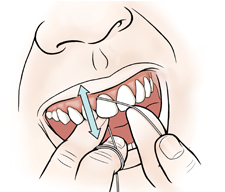Flossing Crowns, Bridges, and Implants
Bacteria collect in every nook and cranny of your mouth. They can cause disease in teeth, gums, and bone. They can even decay teeth beneath dental treatments, such as crowns and bridges (restorations). Brushing cleans bacteria from surfaces that are easy to reach. But it's important to clean where a toothbrush can’t reach, so you need to floss every day.
Daily flossing
Flossing daily removes bacteria from between teeth, under bridges, and around implants.
-
Clean all surfaces under and around a restoration just as well as you clean your natural teeth. The method is also pretty much the same.
-
Flossing can be done with a floss holder or disposable floss tool. These let you floss with one hand. This might allow you to floss while doing other tasks, like working at your desk.
-
To floss most effectively:
-
Take about 18 inches of floss and wrap the ends around your middle fingers.
-
Gently slide the floss between your teeth. Wrap it in the shape of a C against the side of a tooth. Slide it up and down against both sides of each tooth several times. Be sure to also floss the back side of your last tooth on each side.

Cleaning aids
Special cleaning aids can make it easier to clean all surfaces of your teeth:
-
Denture cleansers reach denture surfaces that brushing misses.
-
Floss holders help you floss in hard-to-reach places.
-
Interdental or interproximal brushes clean inside spaces, like under a bridge or between teeth.
-
Electric toothbrushes help you clean teeth with greater efficiency and less effort.
© 2000-2025 The StayWell Company, LLC. All rights reserved. This information is not intended as a substitute for professional medical care. Always follow your healthcare professional's instructions.